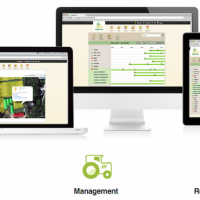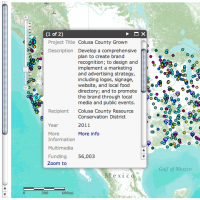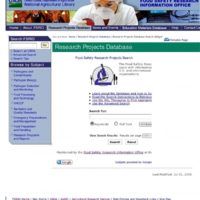 The United States Department of Agriculture (USDA) has been hard at work trying to figure out how to make their resources and data more accessible and easier to navigate. Now, the agency is putting its efforts to the test with the launch of its first Code Sprint, asking developers to create web-based tools and apps that make it easier for farmers, ranchers and others affected by the drought to get information on drought conditions and Federal relief.
The United States Department of Agriculture (USDA) has been hard at work trying to figure out how to make their resources and data more accessible and easier to navigate. Now, the agency is putting its efforts to the test with the launch of its first Code Sprint, asking developers to create web-based tools and apps that make it easier for farmers, ranchers and others affected by the drought to get information on drought conditions and Federal relief.
Why? The U.S. is currently undergoing the most extreme drought the country has faced in the last 25 years. 65.5 percent of the continental U.S. is suffering from some form of drought, according to recently released data from the U.S. Drought Monitor. Farms throughout the Midwest are facing withering crops and scarce, expensive feed for livestock. While consumers will likely feel the effects of these realities at the grocery store in 2013, farmers and ranchers are already struggling with this reality.
Some tools the USDA would like to see developed include:
apps that provide “one-click” access to the nearest USDA service centers and available drought programs; county-level drought disaster designations and program eligibility; information on Federal assistance available based on location and sector; types of loans or refinance options available with a handy repayment calculator and eligibility requirements; drought maps; and localized weather outlooks.
I imagine that many of the developers who may be interested in helping do not personally know farmers or have experience developing technologies for them, so I spoke with the USDA to help sketch out basic user personas and needs for the people they envision using the tools. My Q&A with Illinois Director, Rural Development USDA Colleen Callahan follows below.
I encourage farmers, ranchers or anyone who would benefit from these tools to post comments about the kinds of tools that would be most useful for you in the comments section below. The Code Sprint runs until October 24, 5pm ET. More information about the Code Sprint and data sources are available here.
______________________________
Danielle Gould: What kinds of information on drought conditions and federal relief are farmers looking for?
Colleen Callahan: The first thing farmers should know is their Drought Disaster Declaration status. USDA updates the Secretarial disaster designation list weekly. They should know that having a Secretarial disaster designation in their county could open the door for USDA Emergency Loans and other assistance. And they should know how to contact a local USDA representative for more assistance.
In addition, producers should be able to look through and understand the USDA programs and policies that have been put in place to help them in times of drought. Generally speaking, producers want to know what programs are available now that they could sign up for.
Depending on their situation, producers may be looking for different things. In some areas the main concern may be about livestock feed availability, and producers will be curious to know what is available in terms of emergency feed supply. Grain and other crop producers may primarily want to know about crop insurance procedures. Producers and communities could also be concerned about water issues, where wells have gone dry, impacting both livestock and human needs. Communities may be seeking assistance regarding their water supply, economic concerns, housing issues (some homes have cracked foundations as a consequence of dry soil).
DG: How are farmers currently accessing this information?
CC: Farmers often reach out their local USDA representative in their State or county, or search for the latest information on various USDA websites. In particular, our web page – usda.gov/drought – centralizes information for producers regarding the drought.
It’s also important to remember that the Federal government is not the only entity with programs to help or information to provide, and producers often reach out to a wide variety of others. Every year – disaster or no disaster – many farmers and ranchers work with a wide variety of people to help maximize their yields.
This includes their crop consultant, seed company representative, crop insurance agent, livestock feed supplier, University extension office, or others – and producers will often reach out to these individuals as well for help during disaster.
Through the Drought Code Sprint, we hope to streamline access to USDA and other official information and resources. Our goal is to make Federal resources as accessible as possible to producers, as well as those who work with them on a daily basis, and prevent them from having to visit multiple Federal agency web sites that may not have what they need.
DG: What are the specific challenges/problems with the ways they are currently accessing this information?
CC: It is time consuming to search multiple web sites, reach out to different offices or contacts. Also, there is a risk of receiving outdated or incorrect information. By making USDA’s information accessible in one place through a tool or app, farmers can trust its reliability and currency.
DG: Are there any technologies that solve similar problems?
Company websites, such as seed, fertilizer, feed, etc. Also commodity-specific websites.
DG: How would a farmer use the tool? Are they accessing them through mobile devices or the computer? If mobile devices, are they using smartphones?
CC: Through the Code Sprint, we’re seeking any and all development. As farmers often access information from their mobile devices and smartphones, we would love to see mobile optimized content or apps.
DG: Who can developers contact if they have questions?
CC: They can contact me directly by email, or tweet us a question to @USDA. Developers can also post a comment to the blog post and we’ll answer there for the benefit of the community. Developers can also reach out to me by email at colleen.callahan@il.usda.gov
DG: What will happen with the tools after the Code Sprint?
CC: We will feature some of the tools on the USDA website and Drought resources pages and raise awareness among our stakeholders and those who rely upon Federal information.






